Laptop Mag Verdict
The HP SlateBook 14 brings Android to a full-size touch-screen notebook, but the marriage doesn't work.
Pros
- +
Slim and attractive design
- +
Loud audio
- +
Excellent battery life
- +
Comfortable keyboard
Cons
- -
Sluggish performance
- -
Finicky touchpad
- -
Grainy display with shallow viewing angles
Why you can trust Laptop Mag
Sometimes, you shouldn't try to reinvent the wheel. Case in point: the HP SlateBook 14, which unceremoniously shoves Android 4.3 into a laptop chassis. The result of this odd coupling is a $429 notebook with an undeniably attractive chassis and long battery life -- plus a lot more apps than Chromebooks offer. But the display and performance are both lackluster.
With the increasingly popularity of Chromebooks, as well as inexpensive Windows notebooks, why do we need or want a laptop running a mobile OS when there are cheaper, more efficient devices already on the market? Answer: You don't.
Design
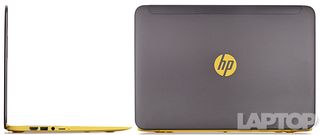
To quote the Temptations, the SlateBook 14's design is "like sunshine on a cloudy day." I was immediately smitten by the bright-yellow HP logo in the center of the matte black lid, as well as the marigold undercarriage. I wish HP didn't reserve this color just for the SlateBook. Though cool to the touch, the lid was, unfortunately, highly susceptible to fingerprints.
HP played it safe with the interior, making the deck out of the same black aluminum from the lid. The effervescent yellow is still there in the form of a thin border along the sides of the notebook as well as the tallow-hued hinges. Directly below the hinge, you'll see an integrated speaker grille and a power button in the top left corner. The full-size keyboard resides in a recess above a fairly large touchpad.
MORE: 5 Best HP Laptops
At 3.6 pounds, the HP SlateBook 14 makes the HP Chromebook 14 (4 pounds) feel heavy. The SlateBook measures a barely there 13.54 x 9.45 x 0.63 inches. The Chromebook 14 is a thicker 13.56 x 9.44 x 0.81 inches.
Display

Click to EnlargeFull HD? You could have fooled me. The SlateBook 14's 1920 x 1080p touch-screen panel is woefully lacking in detail. As I watched the 1080p trailer for Get On Up, I was struck by the amount of artifacts I saw throughout darker scenes. A scene where singer/actress Jill Scott poses in a sensual, black, diaphanous gown was marred by pixelation. I was also disappointed by how flat colors looked on the 14-inch panel. Chadwick Boseman's fire-red suit looked dreary, diminishing his confident saunter toward the stage. Viewing angles were terrible, with colors inverting as I moved anywhere past 45 degrees.
Part of the SlateBook's troubles lie in the panel's ability to handle color. According to our measurements, the screen can display only 72 percent of the sRGB gamut, which is below the 77 percent thin-and-light average. That's still better, however, than the HP Chromebook 14's 61 percent and the Aspire V3's 66.4 percent.
On the Delta-E test, which measures color accuracy, the SlateBook 14 hit 13.6, which is far from a perfect 0. The Aspire V3 fared better at 6.3, but neither could match the Chromebook 14, which registered a fairly accurate 1.3.
The SlateBook averaged 226 nits on the brightness test, surpassing the 219-nit average. That's much brighter than the Chromebook 14 and the Aspire E1, which posted 209 and 171 nits, respectively.
Touch-Screen Performance

Click to EnlargeTo hammer home the fact that the SlateBook is, indeed, an Android device, the Back, Home and Recent Apps icons sit at the bottom of the screen in an omnipresent black bar. HP added physical keyboard buttons to perform those functions, so that bar is taking up precious display space.
The 10-point capacitive touch screen was accurate and swift, allowing me to effortlessly navigate between screens and deploy the notifications and settings shades.
MORE: 25 Best Android Apps
Audio
The SlateBook 14's speakers pack a wallop for such a slim chassis. The laptop hit 102 decibels, overpowering the 82 dB average, the Chromebook 14 (89 dB) and the Aspire V3 (92 dB).
Assisted by Beats Audio technology, the laptop successfully filled my small testing room with loud, relatively balanced audio. The clarinet at the beginning of Ledisi's "I Blame You," was light and playful, joined by healthy bass, crisp piano chords and steady guitar accompaniment.
My only complaint was with the artist's powerful vocals; they sounded a little submerged compared to the rest of the track.
Keyboard

Click to EnlargeThe SlateBook 14 has a full-size island-style keyboard. Similar to most HP keyboards, the four corner buttons are rounded. The springy feedback of the keys, combined with the plentiful palm rest, made for a comfortable typing experience. The keys have a travel of 1.9mm (we like to see at least 1.5 mm of travel) and require 55 grams of force to depress. I managed to type 50 words per minute on the 10 Fast Fingers Typing Test, which is comparable to my usual rate.
Touchpad
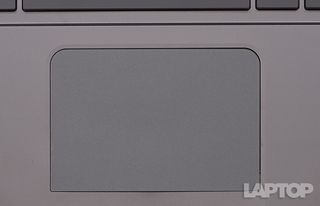
Click to EnlargeI'm glad that HP had the foresight to add such a responsive touch screen, because the 4 x 2.75-inch touchpad on the SlateBook 14 is a dicey proposition. I had a fairly easy time navigating websites and documents, but ran into difficulties when I tried to start clicking on objects.
When I attempted to drag and drop apps to different locations on the desktop, the cursor would stick. The touchpad also has poor palm rejection, as it would switch programs nearly every time I accidentally grazed it. Unfortunately, since this an Android device, there's no option to adjust mouse sensitivity.

Click to EnlargeI ended up bypassing the touchpad issue by plugging in my Razer Naga mouse. It was an effective solution until it came time to play games. I attempted to play N.O.V.A. 3 in traditional mouse and keyboard format, but quickly discovered this was impossible.
While I could use the mouse to click the trigger button on the screen, I couldn't aim the gun, and the game didn't recognize typical movement keys (W, A, S and D). I ended up trying to awkwardly maneuver around the board using the touch display. I wouldn't have had such a bad experience if the SlateBook 14 were a detachable or foldable hybrid that I could use in tablet mode. Instead, I quickly died from lead poisoning from all the bullets I ate.
Thankfully, I finally got my hands on a Bluetooth Android controller. I wouldn't recommend playing anything but Angry Birds or a point-and-click game using just the touchpad.
Heat
After streaming a full-screen Hulu video for 15 minutes, the SlateBook's touchpad measured a cool 79 degrees Fahrenheit. The space between the G and H keys hit a warmer 84 degrees. The bottom of the notebook read 97 degrees, which is 2 degrees above our comfort threshold. However, I used the SlateBook in my lap for more than 2 hours with no discomfort.
HP included its Cool Control setting to help regulate the SlateBook's temperature. Similar to HP's CoolSense technology, when enabled, Cool Control adjusts performance settings to keep temperatures from getting too warm.
MORE: 12 Worst Android Annoyances and How to Fix Them
Webcam
Grainy details and washed-out color awaits you on the SlateBook 14's 720p integrated webcam. Test shots were rife with visual noise, making the text on the Laptop Mag banner in the background fuzzy and difficult to read in some places. My skin tone appeared darker than normal, and the red in my shirt was dull.
Ports

Click to EnlargeThe SlateBook has a pair of USB 2.0 ports and the power jack on the right. On the left, there's a USB 3.0 port, as well as a microSD slot and an HDMI port.
User Interface
Fans of stock Android will have a field day with the SlateBook 14. HP outfitted the laptop with a virtually untouched version of Android 4.3 (Jelly Bean), consisting of five traditional home screens.

Click to EnlargeThe main screen features a large digital-clock widget with the date and a long Google search button at the top of the display. A persistent row of nine icons resides at the bottom of the screen, including Google Chrome, Email, WPS Office, Apps and HP Connected Music. All the icons, with the exception of the Apps button, can be swapped out for other apps.
A black bar at the top of the UI holds icons for various notifications on the left and indicators for battery and Wi-Fi, with a small, blue clock on the right. Sliding down from the left reveals the notifications shade, while doing so from the right side displays the Settings menu.
Ease of Use

Click to EnlargeJust because you can cram Android into a laptop doesn't mean you should. The OS is ill-suited to basic notebook functions. I tried selecting a line of text in a CNN.com article to copy and paste into a waiting Google Doc. While I could click on things with the touchpad, the art of highlighting a line of text and copying was way out of its wheelhouse.
I plugged in my mouse, hoping for a workaround, but Android 4.3 didn't recognize left and right mouse clicks. From there, I tried the tablet/smartphone two-finger-select method to copy and paste this eight-word sentence, without any success.
I finally hit pay dirt when I switched to Google Docs and Kingsoft Office. The touchpad sprung to life, allowing me to select text for copying and pasting. However, because it's an Android machine, I had to use the two prongs to highlight my selection, instead of painting my text with a quick swipe across. It's little annoyances like this that make the idea of using the SlateBook as my everyday productivity machine highly unlikely.
MORE: 10 Best Android Apps You're Not Using
Apps

Click to EnlargeIn its quest to become a viable workstation, HP outfitted the SlateBook 14 with a number of apps targeting productivity and file management. Kingsoft Office allows you to create Word documents along with Microsoft Office-compatible memos, spreadsheets and slideshows.
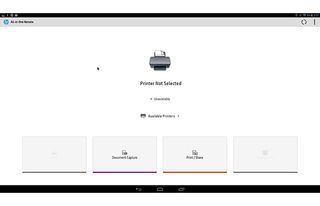
Click to EnlargeHP File Manager aggregates content into easy-to-search folders, while HP Connected Drive and the Box app allow you to share and access files between devices. If you ever need to print anything, HP added its ePrint app. The All-in-One Remote app takes things a bit further, enabling scanning, printing and access to cloud services.
Other HP-branded apps include Connected Music, Media Player and Connected Photo.
Evernote, Hulu, TegraZone, Skype, Skitch and Splashtop (the latter of which streams your Mac or PC desktop to your Android device) make up the rest of the third-party apps on the SlateBook 14.
Performance
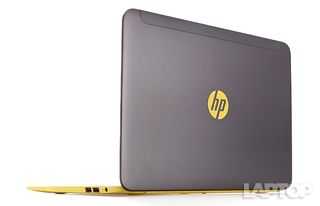
Click to EnlargeThe HP SlateBook 14 sports a 1.8-GHz Nvidia Tegra 4 CPU, 2GB of RAM and 16GB of eMMC storage, which combine to deliver mixed performance. Most apps took less than a second to open, with the exception of the resource-intensive N.O.V.A. game (13 seconds).
On synthetic benchmarks, such as the Peacekeeper browser test, the SlateBook 14 scored 971, which is well below the 1,381 notched by the $370 Acer Aspire V3-111P (2.6-GHz Intel Pentium N3540 CPU). The $279 HP Chromebook 14 and its 1.4-GHz Intel Celeron 2955U hit 2,771, matching the thin-and-light average.
The SlateBook 14 finished the JavaScript SunSpider test in 768.7 milliseconds, which is rather sluggish compared to the Chromebook 14 and Aspire V3, which had times of 408.9 ms and 454.7 ms, respectively.
The SlateBook 14 took a long 40 seconds to boot up. The Chromebook 14's 16GB SSD started Chrome OS in a blistering 6 seconds, while the Acer Aspire E1-470P's 500GB SATA hard drive launched Windows 8 in 22 seconds.
Battery Life
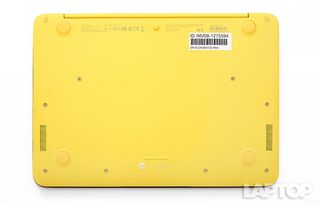
Click to EnlargeThe SlateBook 14 lasted an impressive 8 hours and 19 minutes on the Laptop Mag Battery Test (continuous Web surfing over Wi-Fi at 150 nits). That runtime is more than an hour longer than the 6:58 thin-and-light laptop average. The HP Chromebook 14 clocked in at 7:57, while the Acer Aspire V3-111P topped out at 6:22.
MORE: 10 Laptops with the Longest Battery Life
Bottom Line

Click to EnlargeIf the SlateBook 14 were a detachable or convertible and you could use it in tablet mode, it would make more sense. What's the point of having Android if you can't take full advantage of it? Instead, you're left with a laptop that's plagued with a dull display with shallow viewing angles, a finicky touchpad and lackluster performance.
That's not to say there aren't some bright spots -- the notebook delivers good audio, long battery life and a comfortable keyboard. But I'm not convinced that that's enough to get shoppers to plunk down $429 when they could get the $299 HP Chromebook 14 or the $379 Acer Aspire V3, both of which offer better displays and performance for less money. Never send a SlateBook to do a Chromebook or a budget Windows laptop's job.
HP SlateBook 14 Specs
| Bluetooth | Bluetooth 4.0 |
| Brand | HP |
| CPU | 1.8-GHz Nvidia Tegra 4 |
| Card Slots | microSD |
| Company Website | www.hp.com |
| Display Size | 14 |
| Hard Drive Size | 16GB |
| Hard Drive Speed | n/a |
| Hard Drive Type | eMMC |
| Native Resolution | 1920x1080 |
| Operating System | Android 4.3 |
| Optical Drive | None |
| Optical Drive Speed | n/a |
| Ports (excluding USB) | USB 3.0, USB 2.0, Headphone/Mic, HDMI |
| RAM | 2GB |
| Size | 13.54 x 9.45 x 0.63 inches |
| Touchpad Size | 4 x 2.75 inches |
| USB Ports | 3 |
| Warranty/Support | 1-Year Hardware Limited Warranty with Toll-Free Technical Support and 90-Days Limited Software Technical Support |
| Weight | 3.6 pounds |
| Wi-Fi | 802.11b/g/n |

Sherri L. Smith has been cranking out product reviews for Laptopmag.com since 2011. In that time, she's reviewed more than her share of laptops, tablets, smartphones and everything in between. The resident gamer and audio junkie, Sherri was previously a managing editor for Black Web 2.0 and contributed to BET.Com and Popgadget.